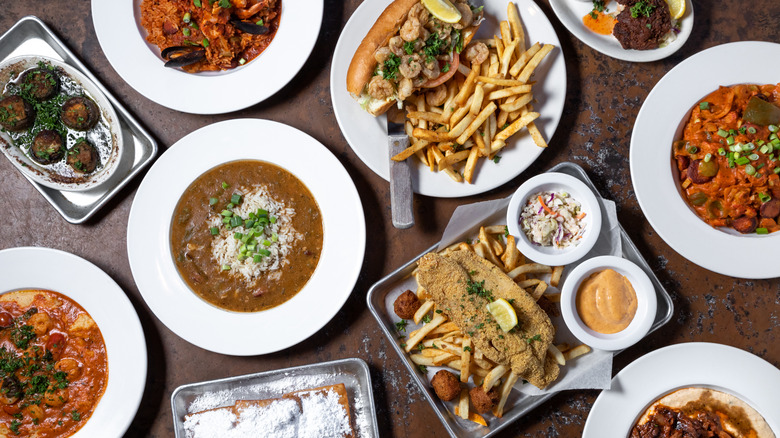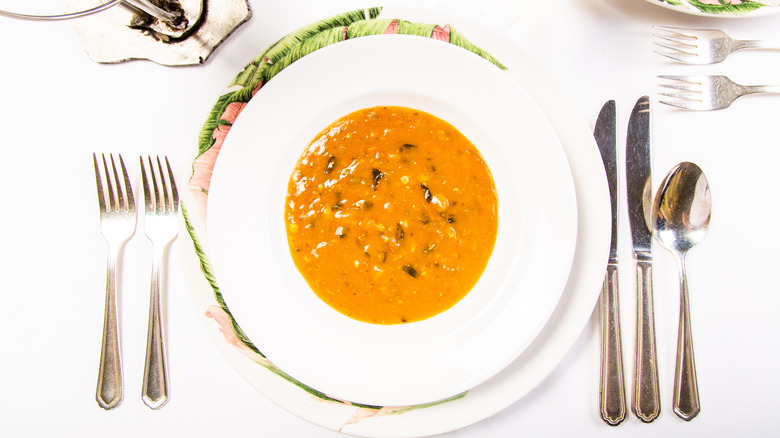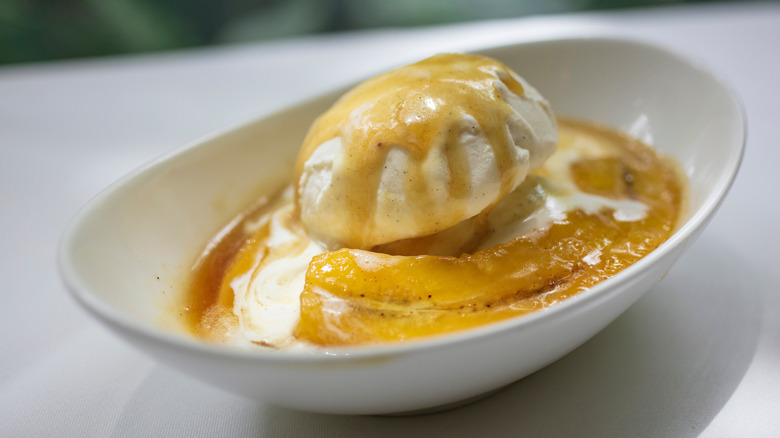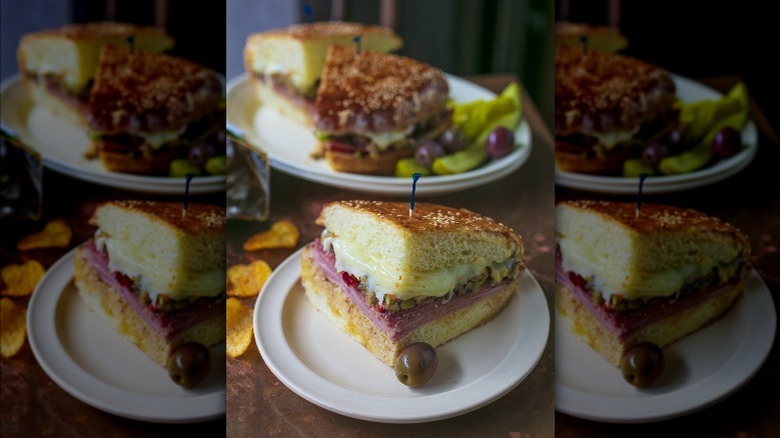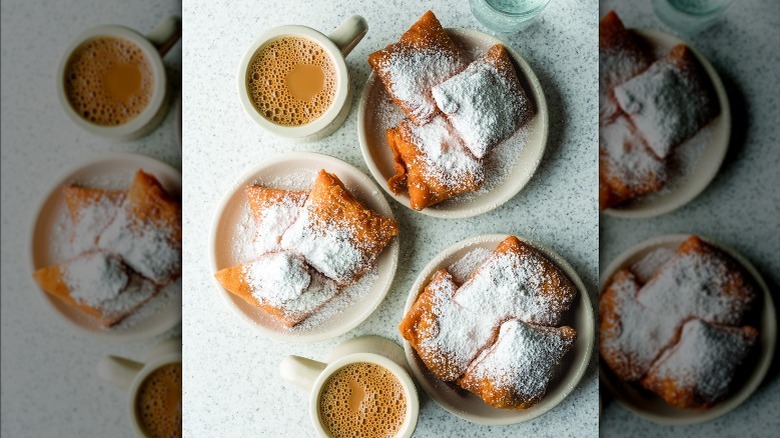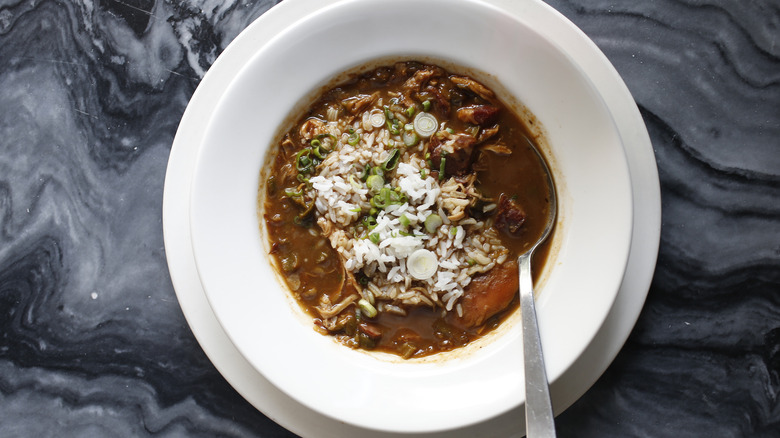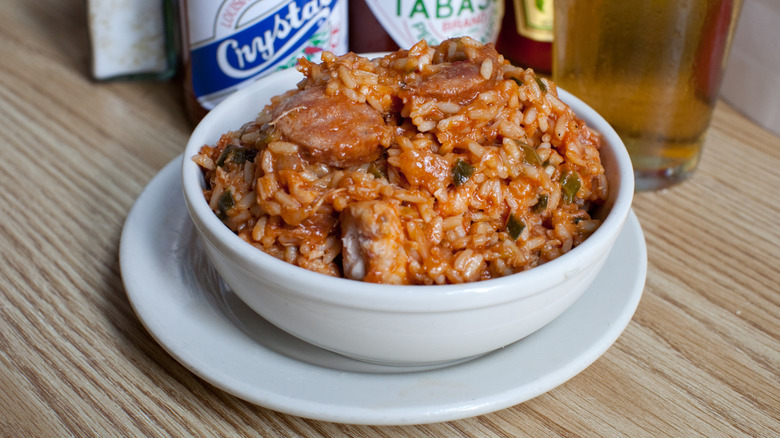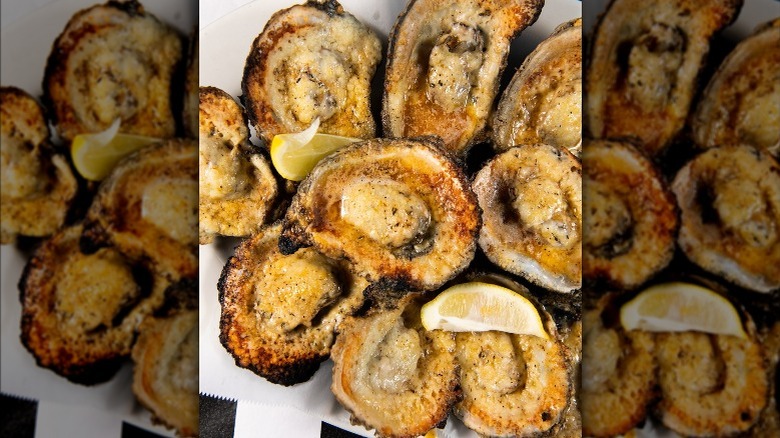9 Must-Try New Orleans Dishes And Where To Taste Them
There is never a shortage of fun to be had in New Orleans. The Big Easy is packed with gorgeous, storied neighborhoods to visit, like the French Quarter and Garden District, world class art to admire, unrivaled jazz to listen to, and, of course, plenty of mouth-watering cuisine to taste. In fact, the city's culinary heritage runs so deep and is so unique, there are entire tours dedicated to learning about NOLA's rich food and cocktail history.
From decadent soups and sandwiches to hearty mains and flashy desserts, New Orleans has given us countless unique dishes. Indeed, choosing where to eat in New Orleans is no easy feat due to the sheer volume of great options. That being said, if you're looking to eat your way through the city's most storied offerings, we're here to help. Read on to discover nine must-try New Orleans dishes and where to taste them.
Po' boys at Verti Marte
Perhaps no dish is as synonymous with New Orleans as the humble po' boy. As NOLA.com explains, the sandwich was reportedly invented during the 1929 streetcar strike when brothers Benny and Clovis Martin proclaimed they would feed all streetcar drivers for free. According to legend, Benny once explained that whenever he and his brother would see a driver they'd say, "Here comes another poor boy" which inspired the name of the sandwich. This was later adjusted to po' boy, but as 64 Parishes notes, the actual origins of its name have been greatly debated.
Whatever you want to call them, po' boys were a hit and today, they're served all around the city. With so many options, it can be hard to choose, but Verti Marte is considered by many to be the top spot for the sandwich. The half-bodega, half-deli on Royal Street is open 24/7 and was called "a locals' best-kept secret" by tripsavvy, which dubbed it the spot for sandwiches in the French Quarter. While there are several po' boy options, including classics like oyster and shrimp, its signature creation, the All That Jazz, is not to be overlooked. Described by Travel + Leisure as "an insane stack," it features layers of grilled turkey, ham, fried shrimp, sautéed mushrooms, American cheese, Swiss cheese, and the tartar-like "wow" sauce (via Adrian Brijbassi). Though it may require several napkins to consume, the All That Jazz is well worth the inevitable mess.
Turtle soup at Commander's Palace
Commander's Palace is a New Orleans institution. Instantly recognizable thanks to its signature "Commanders Blue" and white façade, the Garden District restaurant has been feeding folks since 1893. Its tantalizing menu is made up of Creole essentials, like gumbo and crawfish, but there's one must-try dish that really stands out: turtle soup. As NPR points out, it used to be all the rage in 19th century America, at least for upper class diners. The dish was so popular that it nearly decimated the terrapin population. In a push to avoid extinction, restrictions were put in place, sparking the gradual disappearance of turtle soup as a mainstream staple. These days, it's hard to find — unless you head straight for Commander's Palace.
The restaurant's turtle soup au sherry is prepared with a veal fond base and also includes chopped egg and crushed lemon. Aged sherry is added tableside for a flashy final flourish. This NOLA classic has been on the restaurant's menu since it first opened its doors over 100 years ago. The restaurant's award-winning chef Tory McPhail spoke about the soup's appeal with Eater, explaining, "It's not just an iconic dish for Commander's but for all of Louisiana." Diners agree with one reviewer on Tripadvisor calling it "to die for."
Bananas Foster at Brennan's
Owen Brennan's Vieux Carré Restaurant made its Bourbon Street debut in 1946 and, just a few years later, it made an unrivaled contribution to the city's culinary landscape (via Brennan's). It was the early 1950s and, as the story goes, founder Owen Brennan wanted to create a dessert in honor of his friend, Richard Foster. There were no set guidelines, except that it had to feature one specific fruit. Brennan had more bananas than he knew what to do with thanks to a surplus from his family's produce company, Brennan's Processed Potato Company, so he enlisted his sister, along with the restaurant's chef, to dream up a banana-centric sweet. Thus, the legendary bananas Foster was born.
About a decade later, the restaurant moved to Royal Street (where it's been ever since) and it took the dessert with it. To create the sweet dish, bananas are cooked with butter, sugar, cinnamon, and banana liquor, then flambéed with rum before being served atop ice cream. Not surprisingly, the flashy dessert is the restaurant's most popular order. As descendant Ralph Brennan told Southern Living, "It's a very rich, sinful dessert," but it's not just the taste that's appealing. According to Brennan, the real draw is "the whole show that you get. People love to see it, and we get a lot of people who come in here to get only that dish." Indeed, TasteAtlas ranked it the best bananas Foster in the world.
Muffaletta at Napoleon House
New Orleans is home to not just one but two renowned sandwiches. While many people instantly think of the po' boy, there's actually an even older (and equally mouthwatering) sandwich that was born in the Big Easy. In the late 19th century, Sicilians began fleeing their native Italy in search of a better life and many found their way to New Orleans. After settling in the lower French Quarter, an area that would be referred to as "Little Palermo" (via NewOrleans.com), they began to infuse the city with their culture, traditions, and food. Their biggest contribution to NOLA cuisine came in the form of the muffuletta, which first appeared in the city in the 1890s (via Muffuletta Festival).
The traditional muffuletta sandwich recipe is prepared by layering cured meats (think mortadella, salami, ham) with provolone cheese and olive salad on a round loaf of sesame seed bread. Initially served up in Italian grocery stores and delis, Napoleon House put it on its menu when it opened in 1914 and its rendition is tough to beat. There, it's heated up, taking all those flavors to another level. It's no wonder that Condé Nast Traveler deemed it among the best muffuletta sandwiches you'll find in the city.
Beignets at Café Du Monde
If you enjoy crullers, fried dough, or donuts, you're bound to enjoy beignets. They first appeared in Louisiana thanks to the Acadians and are basically fried dough that's heavily coated with powdered sugar. A fresh beignet and coffee are a great breakfast staple and a must-try in the Big Easy.
Locals will argue over who serves the absolute best beignets in New Orleans, but it's hard to top the taste and history of Café Du Monde, which has been serving the pillowy (and messy) treats since it opened in 1862 as a coffee stand in the French Market. As one beignet fan wrote for Delish, tourists should consider a stop at the Decatur St. icon multiple times during their visit. Open 24/7, it's the place to go for piping hot beignets at all hours of the day (and night). Pairing the fried doughy goodness with a signature chicory-flavored coffee (hot or iced) completes the experience.
Gumbo at Herbsaint
Gumbo has been documented in New Orleans since the early 1800s. According to 1885's "The Creole Cookery Book" (via Southern Foodways Alliance), the dish traditionally combined leftover hunks of meats along with various seafood options like shrimp, oyster, and crab, plus some rice. Whatever the mix, it's always packed with flavorful spices (think dark chile powder, paprika) and vegetables to deliver, as The New York Times explains, a dish that's thicker than a soup but not quite a stew.
However, despite its storied history, its popularity began to wane in recent years, until local chefs started getting creative. One of the most devoted proponents of a gumbo revolution has been chef Donald Link who's been mixing things up at his various restaurants, including Herbsaint, which opened in 2000. There, the gumbo is sometimes served with turkey, tasso ham, and andouille sausage. Other times, duck makes it into the dish, and sometimes shrimp and crab join the mix. Speaking with The New York Times, Link, who has Cajun roots, shared how he took memories from the gumbo he ate as a child and fused it with the inspiration he found during multiple Caribbean trips to investigate the dish's history. His experimentation paid off. Lonely Planet proclaimed that it "might be the best restaurant gumbo in town."
Jambalaya at Mother's
Often mixed up with gumbo, jambalaya does share some similarities with its soup-y counterpart, but it's actually a rice dish. As Chowhound explains, it's a great representation of the melting pot culture of NOLA as it draws influence from paella, brought to Louisiana by Spanish settlers, but also infuses the tastes and history of France, Germany, and the Caribbean. Rice is mixed with protein, veggies, and spices to deliver bold flavor in one of two varieties: Creole jambalaya, which uses tomatoes, and Cajun jambalaya, which forgoes them.
It's considered a staple of Louisiana cooking and if you're looking to taste a traditional Creole version, you'll want to head to Mother's. The cafeteria-style restaurant has been pleasing diners since 1983 and its award-winning recipe for Jerry's Jambalaya took home first place at the 1985 La Fete Jambalaya Cook-off. The quintessential rice base is blended with smoked sausage, chicken, spices, vegetables, and creole tomato sauce for a delectable result.
Baked Alaska at Antoine's
Antoine's has been serving French-Creole classics for over 180 years, but it's an unlikely dessert we're spotlighting on this must-taste list. The French Quarter institution is the source of a number of delicious classics, like oysters Rockefeller and pommes de terre soufflées, but one of its most popular dishes is actually a sweet treat they didn't invent: baked Alaska.
According to Martha Stewart, the dessert originated at Delmonico's in New York City following America's purchase of, you guessed it, Alaska in 1867. However, Antoine's soon adopted it. As Chef Michael Regua told Eater, Antoine's sought to offer its own spin on a centerpiece dessert and the restaurant found it in the unique combination of ice cream and meringue. Calling it a "try before you die dish," Chef Regua explained the culinary process: Pound cake is covered in ice cream, topped with meringue, molded, and then set ablaze. He enthused, "It's a simple dessert. It's a tasty dessert, and it's our feature." As Thrillist put it, Antoine's baked Alaska "is not to be missed." Frommer's agreed, cheekily writing that the "frivolous, football-size (and shaped) baked Alaska" is truly a must-have dessert.
Chargrilled oysters at Acme Oyster House
It wouldn't be a list of New Orleans food highlights without oysters. Indeed, NOLA.com went as far as to profess that compared to the rest of the U.S., local oyster culture is incomparable — and they weren't kidding! You'll find them everywhere in the city, served in a myriad of ways, from raw to deep-fried and stuffed in a po' boy sandwich.
One of the tastiest oyster incarnations comes straight off the grill and is being served up at Acme Oyster House. This storied NOLA institution got its start in 1910 and, as its name suggests, is the place to go if you're craving oysters. Enjoy them raw or as a shooter with cocktail sauce and vodka or, as we suggest, chargrilled. Inherited from Native Americans, this method of preparing oysters is an integral part of New Orleans culinary history, per Today. Served sizzling hot, they're topped with a herb butter sauce and bubbling cheese. NewOrleans Restaurants.com warns that there is often a line to grab a seat at Acme Oyster House but it is worth the wait, especially for the grilled oysters (just be sure to have French bread ready to sop all the extra sauce).
